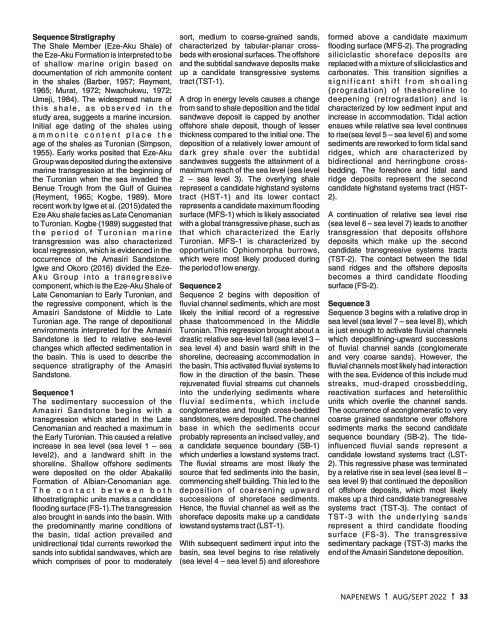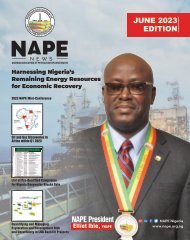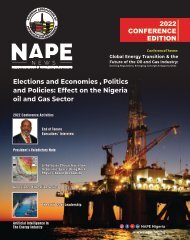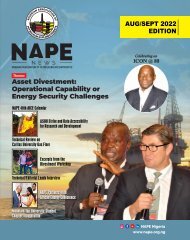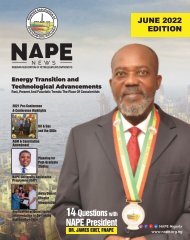Create successful ePaper yourself
Turn your PDF publications into a flip-book with our unique Google optimized e-Paper software.
Sequence Stratigraphy<br />
The Shale Member (Eze-Aku Shale) of<br />
the Eze-Aku Formation is interpreted to be<br />
of shallow marine origin based on<br />
documentation of rich ammonite content<br />
in the shales (Barber, 1957; Reyment,<br />
1965; Murat, 1972; Nwachukwu, 1972;<br />
Umeji, 1984). The widespread nature of<br />
t h i s s h a l e , a s o b s e r v e d i n t h e<br />
study area, suggests a marine incursion.<br />
Initial age dating of the shales using<br />
a m m o n i t e c o n t e n t p l a c e t h e<br />
age of the shales as Turonian (Simpson,<br />
1955). Early works posited that Eze-Aku<br />
Group was deposited during the extensive<br />
marine transgression at the beginning of<br />
the Turonian when the sea invaded the<br />
Benue Trough from the Gulf of Guinea<br />
(Reyment, 1965; Kogbe, 1989). More<br />
recent work by Igwe et al. (2015)dated the<br />
Eze Aku shale facies as Late Cenomanian<br />
to Turonian. Kogbe (1989) suggested that<br />
t h e p e r i o d o f T u r o n i a n m a r i n e<br />
transgression was also characterized<br />
local regression, which is evidenced in the<br />
occurrence of the Amasiri Sandstone.<br />
Igwe and Okoro (2016) divided the Eze-<br />
A k u G r o u p i n t o a t r a n s g r e s s i v e<br />
component, which is the Eze-Aku Shale of<br />
Late Cenomanian to Early Turonian, and<br />
the regressive component, which is the<br />
Amasiri Sandstone of Middle to Late<br />
Turonian age. The range of depositional<br />
environments interpreted for the Amasiri<br />
Sandstone is tied to relative sea-level<br />
changes which affected sedimentation in<br />
the basin. This is used to describe the<br />
sequence stratigraphy of the Amasiri<br />
Sandstone.<br />
Sequence 1<br />
The sedimentary succession of the<br />
Amasiri Sandstone begins with a<br />
transgression which started in the Late<br />
Cenomanian and reached a maximum in<br />
the Early Turonian. This caused a relative<br />
increase in sea level (sea level 1 – sea<br />
level2), and a landward shift in the<br />
shoreline. Shallow offshore sediments<br />
were deposited on the older Abakaliki<br />
Formation of Albian-Cenomanian age.<br />
T h e c o n t a c t b e t w e e n b o t h<br />
lithostratigraphic units marks a candidate<br />
flooding surface (FS-1).The transgression<br />
also brought in sands into the basin. With<br />
the predominantly marine conditions of<br />
the basin, tidal action prevailed and<br />
unidirectional tidal currents reworked the<br />
sands into subtidal sandwaves, which are<br />
which comprises of poor to moderately<br />
sort, medium to coarse-grained sands,<br />
characterized by tabular-planar crossbeds<br />
with erosional surfaces. The offshore<br />
and the subtidal sandwave deposits make<br />
up a candidate transgressive systems<br />
tract (TST-1).<br />
A drop in energy levels causes a change<br />
from sand to shale deposition and the tidal<br />
sandwave deposit is capped by another<br />
offshore shale deposit, though of lesser<br />
thickness compared to the initial one. The<br />
deposition of a relatively lower amount of<br />
dark grey shale over the subtidal<br />
sandwaves suggests the attainment of a<br />
maximum reach of the sea level (sea level<br />
2 – sea level 3). The overlying shale<br />
represent a candidate highstand systems<br />
tract (HST-1) and its lower contact<br />
represents a candidate maximum flooding<br />
surface (MFS-1) which is likely associated<br />
with a global transgressive phase, such as<br />
that which characterized the Early<br />
Turonian. MFS-1 is characterized by<br />
opportunistic Ophiomorpha burrows,<br />
which were most likely produced during<br />
the period of low energy.<br />
Sequence 2<br />
Sequence 2 begins with deposition of<br />
fluvial channel sediments, which are most<br />
likely the initial record of a regressive<br />
phase thatcommenced in the Middle<br />
Turonian. This regression brought about a<br />
drastic relative sea-level fall (sea level 3 –<br />
sea level 4) and basin ward shift in the<br />
shoreline, decreasing accommodation in<br />
the basin. This activated fluvial systems to<br />
flow in the direction of the basin. These<br />
rejuvenated fluvial streams cut channels<br />
into the underlying sediments where<br />
fluvial sediments, which include<br />
conglomerates and trough cross-bedded<br />
sandstones, were deposited. The channel<br />
base in which the sediments occur<br />
probably represents an incised valley, and<br />
a candidate sequence boundary (SB-1)<br />
which underlies a lowstand systems tract.<br />
The fluvial streams are most likely the<br />
source that fed sediments into the basin,<br />
commencing shelf building. This led to the<br />
deposition of coarsening upward<br />
successions of shoreface sediments.<br />
Hence, the fluvial channel as well as the<br />
shoreface deposits make up a candidate<br />
lowstand systems tract (LST-1).<br />
With subsequent sediment input into the<br />
basin, sea level begins to rise relatively<br />
(sea level 4 – sea level 5) and aforeshore<br />
formed above a candidate maximum<br />
flooding surface (MFS-2). The prograding<br />
siliciclastic shoreface deposits are<br />
replaced with a mixture of siliciclastics and<br />
carbonates. This transition signifies a<br />
s i g n i f i c a n t s h i f t f r o m s h o a l i n g<br />
(progradation) of theshoreline to<br />
deepening (retrogradation) and is<br />
characterized by low sediment input and<br />
increase in accommodation. Tidal action<br />
ensues while relative sea level continues<br />
to rise(sea level 5 – sea level 6) and some<br />
sediments are reworked to form tidal sand<br />
ridges, which are characterized by<br />
bidirectional and herringbone crossbedding.<br />
The foreshore and tidal sand<br />
ridge deposits represent the second<br />
candidate highstand systems tract (HST-<br />
2).<br />
A continuation of relative sea level rise<br />
(sea level 6 – sea level 7) leads to another<br />
transgression that deposits offshore<br />
deposits which make up the second<br />
candidate transgressive systems tracts<br />
(TST-2). The contact between the tidal<br />
sand ridges and the offshore deposits<br />
becomes a third candidate flooding<br />
surface (FS-2).<br />
Sequence 3<br />
Sequence 3 begins with a relative drop in<br />
sea level (sea level 7 – sea level 8), which<br />
is just enough to activate fluvial channels<br />
which depositfining-upward successions<br />
of fluvial channel sands (conglomerate<br />
and very coarse sands). However, the<br />
fluvial channels most likely had interaction<br />
with the sea. Evidence of this include mud<br />
streaks, mud-draped crossbedding,<br />
reactivation surfaces and heterolithic<br />
units which overlie the channel sands.<br />
The occurrence of aconglomeratic to very<br />
coarse grained sandstone over offshore<br />
sediments marks the second candidate<br />
sequence boundary (SB-2). The tideinfluenced<br />
fluvial sands represent a<br />
candidate lowstand systems tract (LST-<br />
2). This regressive phase was terminated<br />
by a relative rise in sea level (sea level 8 –<br />
sea level 9) that continued the deposition<br />
of offshore deposits, which most likely<br />
makes up a third candidate transgressive<br />
systems tract (TST-3). The contact of<br />
TST-3 with the underlying sands<br />
represent a third candidate flooding<br />
surface (FS-3). The transgressive<br />
sedimentary package (TST-3) marks the<br />
end of the Amasiri Sandstone deposition.<br />
NAPENEWS AUG/SEPT <strong>2022</strong> 33


